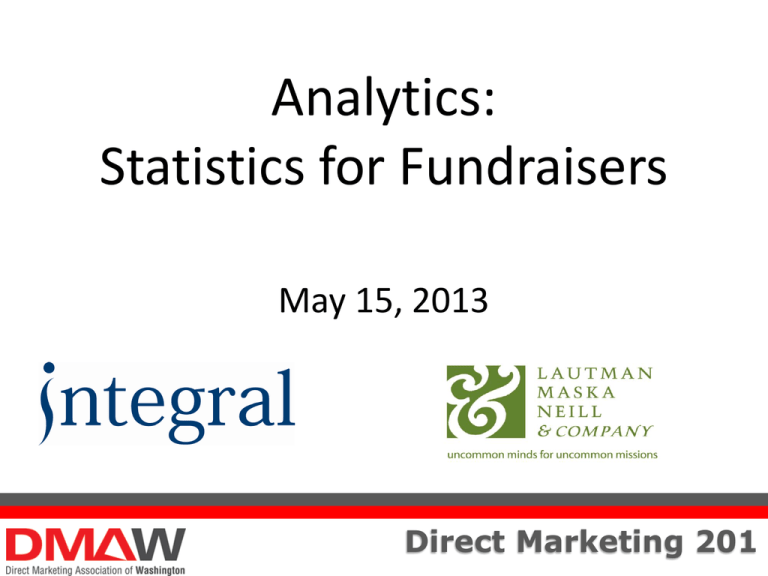to the presentation
advertisement

Analytics: Statistics for Fundraisers May 15, 2013 Direct Marketing 201 The key to maximizing value and sustained growth is getting the right information to the right people at the right time ANALYTICS Direct Marketing 201 What We Will Cover • • • • • Data Sources Types of Analytics Campaign Analytics Forecasting Analytics Monitoring Outcomes Direct Marketing 201 Old Model New Model – need a plan to integrate DATA SOURCES Direct Marketing 201 Sources: The Old Model Web Sites TM Donor/ Customer Direct Mail Events/Major Gifts Direct Marketing 201 You Need a Plan that Integrates the Data Direct Marketing 201 Integrating Data to Develop Strategy Direct Marketing 201 Balancing Analytical Needs Description of Types of Analytics TYPES OF ANALYTICS Direct Marketing 201 Analytics – Balancing LCLS • There are basically 4 types of data that need to constantly be balanced in decision making – each has different value • • • • L – Lagging C – Current L – Leading S – Strategic Benchmarking Campaign Reports/Testing Forecasting/Budgeting Scenario Building/Multi-Year Growth Direct Marketing 201 Analytics – a Few Types • Campaign Analytics – Performance Reports – Package Testing Results • Forecasting Analytics – Budget Forecasting – Cash Flow Forecasting Direct Marketing 201 Analytics – a Few Types • Digital Media Analytics – Web Site Traffic Analysis – Paid Advertising ROI • Communication Analytics – Segmentation Analytics – Predictive Analytics Direct Marketing 201 Analytics – a Few Types • Performance Indicator Reports – Trend Analysis (historic donor value) – Multi-Year Forecasting (future donor value) Direct Marketing 201 Performance Reports Metrics CAMPAIGN ANALYTICS Direct Marketing 201 Performance Reports • Key metrics help determine campaign success – What are they? – How are they calculated? – Why is it important? Why may it be limiting? • Which is most important when? – It depends on your goals! – It depends on the program! Direct Marketing 201 Response Rate • What? – The percentage of the quantity mailed that responded • How? – (# of Gifts/Quantity)*1000 • Why important? – Indicator of package success. More gifts the better! • Why limiting? – Does not factor in revenue, size makes a difference. Direct Marketing 201 Average Gift • What? – The average size of the contribution • How? – Gross Income/# of Gifts • Why important? – The higher the gift, the more valuable the donor • Why limiting? – Does not factor in response, large gifts can skew performance Direct Marketing 201 Gross/M • What? – Gross income per thousand pieces mailed • How? – (Gross Income/Quantity Mailed) * 1000 • Why important? – The more revenue per piece, the better • Why limiting? – Does not factor in cost Direct Marketing 201 Cost/M • What? – Cost per thousand pieces mailed • How? – (Total Cost/Quantity Mailed) * 1000 • Why important? – Tracks costs • Why limiting? – Test vs. rollout pricing need to be considered Direct Marketing 201 Investment/Donor (CTA) • What? – Net Investment to acquire a new donor • How? – Net income/# of Gifts • Why important? – Factors in response AND revenue AND cost • Why limiting? – Only used in prospecting, but it’s a key indicator! Direct Marketing 201 Acquisition Campaign Report Direct Marketing 201 Net/M • What? – Net income per thousand pieces mailed • How? – Gross/M – Cost/M – (Net Income/Quantity Mailed) * 1000 • Why important? – Factors in gross and cost, measures net productivity • Why limiting? – Not really applicable in prospecting when there is traditionally no net revenue Direct Marketing 201 Appeal Campaign Report Direct Marketing 201 Which variable is most important when? It depends, but general rule of thumb is … • • • • Acquisition – Investment/Donor (CTA) Appeals – Net/M Renewals – Response Rate Upgrades – Average Gift Direct Marketing 201 Package Testing – Why? • Build on what’s working, change what isn’t – Tweak Tests, New Package • Move the needle on a specific variable based on program goals – Response rate, Average gift, Net (etc.) • Stay one step ahead of your peers! Direct Marketing 201 Package Testing – When? • As often as possible! – Try and test at least one variable in every mailing • Tests aren’t limited to creative/design – RFM segment testing in appeals – List testing in prospecting (80/20 rule) Direct Marketing 201 Package Testing – How? • Ensure there is enough quantity (and gifts) to be statistically significant • Test only one variable at a time • Make sure segments are equally distributed • Ensure you wait long enough to make a conclusion! Direct Marketing 201 Package Testing – For Statisticians • • • • Confidence Intervals Bell Curves Z Score P Value Direct Marketing 201 Bell Curve CONFIDENCE INTERVAL Lower Actual Upper Direct Marketing 201 Bell Curves Intersecting Package A Package B Overlap? Lower (A) Upper (A) Lower (B) Upper (A) Direct Marketing 201 Acquisition Testing Report Direct Marketing 201 Appeal Testing Report Direct Marketing 201 Package Testing – For Everyone Else • • • • • 9 times out of 10 the result will be the same Lower and Upper Bounds Best Case/Worst Case Scenarios Overlap Which metrics to consider depend on goals of the test Direct Marketing 201 Budget Forecasting Cash flow Forecasting Multi-year Forecasting FORECASTING ANALYTICS Direct Marketing 201 Budget Analysis • Question: “Based on where I am today in my fiscal year cash flow and how campaigns have been performing, where am I going to end the fiscal year.” • Approach: Combining current cash flow to date along with a forecast of “active” campaigns gives an excellent real-time approximation of total fiscal year revenue. Direct Marketing 201 34 Budget Analysis: Tools • Campaign Budgets: All TM, DM, Web, etc. budgets with expected outcomes. • Predictive Flow: using different tools for each channel flow out budget (i.e., DM would use a standard days out). • Estimation of Carry In/Carry Out: Based on timing of prior FY campaigns how much revenue will be “carried into” this FY. Same for current FY Campaigns. Direct Marketing 201 35 Budget Analysis: Results DM Acknowledgments Acquisition Monthly Giving Lapsed Renewals Total DM List Rental Whitemail Total Whitemail/List Restricted (-) Grand Total FY12 Budget Diff FY Thru 9 $83,400 $78,950 $78,960 $80,670 $79,980 $401,960 $79,140 $8,095 $87,235 -$824 $488,371 $548,100 ($59,729) Proj 10 $9,530 $8,100 $8,600 $9,150 $8,200 $43,580 $9,310 $884 $10,194 -$91 $53,683 $60,900 ($7,217) Proj 11 $9,610 $9,370 $8,110 $8,820 $8,510 $44,420 $9,860 $831 $10,691 -$83 $55,028 $60,900 ($5,872) Proj 12 $9,760 $8,140 $9,510 $8,380 $9,340 $45,130 $8,510 $906 $9,416 -$81 $54,466 $60,900 ($6,435) EOY Proj $112,300 $104,560 $105,180 $107,020 $106,030 $535,090 $106,820 $10,716 $117,536 ($1,078) $651,548 FY Budget $120,000 $120,000 $120,000 $120,000 $120,000 $600,000 $120,000 $12,000 $132,000 ($1,200) $730,800 Diff ($7,700) ($15,440) ($14,820) ($12,980) ($13,970) ($64,910) ($13,180) ($1,284) ($14,464) $122 ($79,252) Direct Marketing 201 36 Forecast Analysis Question: “Recent performance metrics are soft compared to last year, how is recent performance going to affect my fiscal year budget.” Approach: “Look at recent cash flow trends based on which campaigns are active and use tools to forecast the remaining months.” Direct Marketing 201 37 Forecast Analysis: Tools • Historical performance by day. • Time-series analysis to utilize recent trends along with historical performance to predict outcome. • Create several forecasts based on assumptions of environment changes. Direct Marketing 201 38 Forecast Analysis - Results Direct Marketing 201 39 Multi-Year Forecasting • Question: “Determine the baseline scenario of business models based on declining performance.” – Analyze what investment levels are realistic given current trends in each business model • Approach: “Establish benchmarks for growth in each program areas including investment levels, return on investment targets, donor return rates, retention targets, donor conversion, and upgrading targets, etc.” – Identify the donor segments of greatest value to guide investment decisions. Direct Marketing 201 40 Multi-Year Forecasting - Tools • Segment the file into the investment channels (i.e., DM acquisition, Web Ads, F2F, etc.) • Estimate performance of the new acquisition channels based on the investment. • Use historical activation, retention and upgrading measures to predict future donor value. • Create scenarios based on modifications of investments or changes in the base file. Direct Marketing 201 41 Multi-Year Forecasting - Results Direct Marketing 201 42 Thank you! Jim Emlet Bryan Evangelista Principal 202-452-9732 jemlet@integral-dc.com www.integral-dc.com Account Supervisor 202-296-9660 bevangelista@lautmandc.com www.lautmandc.com Direct Marketing 201






